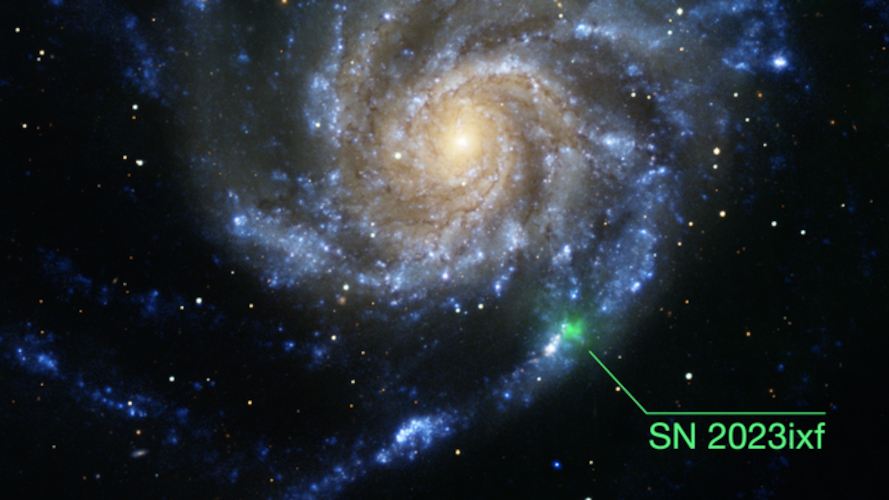
 Credit: NASA/JPL-Caltech/NOIRLab/NSF/AURA/B. Grefenstette (Caltech) Image processing: R. Hurt (Caltech-IPAC)
Credit: NASA/JPL-Caltech/NOIRLab/NSF/AURA/B. Grefenstette (Caltech) Image processing: R. Hurt (Caltech-IPAC)
Rapidly X-raying a Supernova
From death comes life. Massive stars, when they explode, seed their host galaxies with important chemical elements like carbon, oxygen, nitrogen and iron, key constituents of living things. Understanding the details of how this enrichment happens is important to understand how the Universe evolves, and studies of new supernovae provide important clues about the amount of enriched material released. In March 2023, the explosion of a massive red giant star was discovered by amateur astronomer and supernova hunter Koichi Itagaki in the nearby face-on spiral galaxy M101. Because M101 is a favorite target for sky-watchers, it's frequently observed, so the time history of the explosion was seen in very fine detail, pinpointing the time of the explosion to an accuracy of only a few minutes. Because this supernova, dubbed SN2023ixf, was observed so early, and was so nearby, it provides one of the best opportunities to understand how supernovae evolve, and follow-up observations by telescopes on earth and in space were quickly begun. X-ray observations are particularly important. X-rays are produced when the material from the exploded star, moving at speeds in excess of 10 million miles per hour, rams into matter ejected by the star's stellar wind many years prior to the supernova. X-rays thus provide an important measure of the energy of the explosion, and of the history of how the star lost mass in the years before the supernova. The outer material is initially fairly dense, which means that only high-energy X-rays can penetrate through this absorption. NASA's NuSTAR X-ray space telescope was designed to observe and image very high-energy X-rays, beyond the energy range of most X-ray cameras. The NuSTAR images of M101, obtained just a few days after the supernova was detected, provide for us a measure of the high-energy X-ray emission of the supernova at the earliest times after the explosion. The image above shows a zoom-in of M101, with the NuSTAR detection of SN2023ixf shown in green. The variation in the high-energy X-rays detected by NuSTAR, compared to the low-energy X-rays detected by other X-ray observatories, provides an important measure of the history of how the energy of the shock changes, and how the progenitor of SN2023ixf lost mass in the years leading up to the explosion.
Published: January 29, 2024
<
HEA Dictionary ● Archive
● Search HEAPOW
● Other Languages
● HEAPOW on Facebook
● Download all Images
● Education ● HEAD
>

Each week the HEASARC
brings you new, exciting and beautiful images from X-ray and Gamma ray
astronomy. Check back each week and be sure to check out the HEAPOW archive!
Page Author: Dr. Michael F. Corcoran
Last modified Tuesday, 27-Feb-2024 10:15:19 EST


